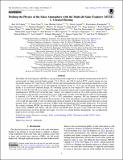Probing the physics of the solar atmosphere with the Multi-slit Solar Explorer (MUSE). I. Coronal heating
Date
11/02/2022Author
Funder
Grant ID
647214
ST/W001195/1
ST/S000402/1
Metadata
Show full item recordAbstract
The Multi-slit Solar Explorer (MUSE) is a proposed mission composed of a multislit extreme ultraviolet (EUV) spectrograph (in three spectral bands around 171 Å, 284 Å, and 108 Å) and an EUV context imager (in two passbands around 195 Å and 304 Å). MUSE will provide unprecedented spectral and imaging diagnostics of the solar corona at high spatial (≤0.″5) and temporal resolution (down to ∼0.5 s for sit-and-stare observations), thanks to its innovative multislit design. By obtaining spectra in four bright EUV lines (Fe ix 171 Å, Fe xv 284 Å, Fe xix–Fe xxi 108 Å) covering a wide range of transition regions and coronal temperatures along 37 slits simultaneously, MUSE will, for the first time, “freeze” (at a cadence as short as 10 s) with a spectroscopic raster the evolution of the dynamic coronal plasma over a wide range of scales: from the spatial scales on which energy is released (≤0.″5) to the large-scale (∼170″ × 170″) atmospheric response. We use numerical modeling to showcase how MUSE will constrain the properties of the solar atmosphere on spatiotemporal scales (≤0.″5, ≤20 s) and the large field of view on which state-of-the-art models of the physical processes that drive coronal heating, flares, and coronal mass ejections (CMEs) make distinguishing and testable predictions. We describe the synergy between MUSE, the single-slit, high-resolution Solar-C EUVST spectrograph, and ground-based observatories (DKIST and others), and the critical role MUSE plays because of the multiscale nature of the physical processes involved. In this first paper, we focus on coronal heating mechanisms. An accompanying paper focuses on flares and CMEs.
Citation
De Pontieu , B , Testa , P , Martínez-Sykora , J , Antolin , P , Karampelas , K , Hansteen , V , Rempel , M , Cheung , M C M , Reale , F , Danilovic , S , Pagano , P , Polito , V , De Moortel , I , Nóbrega-Siverio , D , Van Doorsselaere , T , Petralia , A , Asgari-Targhi , M , Boerner , P , Carlsson , M , Chintzoglou , G , Daw , A , DeLuca , E , Golub , L , Matsumoto , T , Ugarte-Urra , I , McIntosh , S W & the MUSE team 2022 , ' Probing the physics of the solar atmosphere with the Multi-slit Solar Explorer (MUSE). I. Coronal heating ' , Astrophysical Journal , vol. 926 , no. 1 , 52 . https://doi.org/10.3847/1538-4357/ac4222
Publication
Astrophysical Journal
Status
Peer reviewed
ISSN
0004-637XType
Journal article
Rights
Copyright © 2022. The Author(s). Published by the American Astronomical Society. Original content from this work may be used under the terms of the Creative Commons Attribution 4.0 licence. Any further distribution of this work must maintain attribution to the author(s) and the title of the work, journal citation and DOI.
Description
Funding: I.D.M. has received support from the UK Science and Technology Facilities Council (Consolidated grant ST/K000950/1), the European Union Horizon 2020 research and innovation program (grant agreement No. 647214), and the Research Council of Norway through its Centres of Excellence scheme, project number 262622.Collections
Items in the St Andrews Research Repository are protected by copyright, with all rights reserved, unless otherwise indicated.

